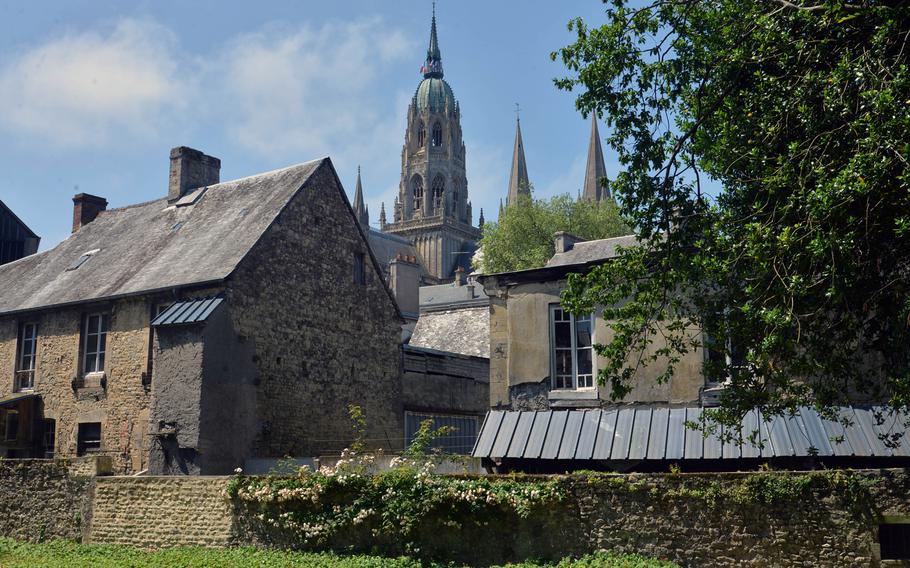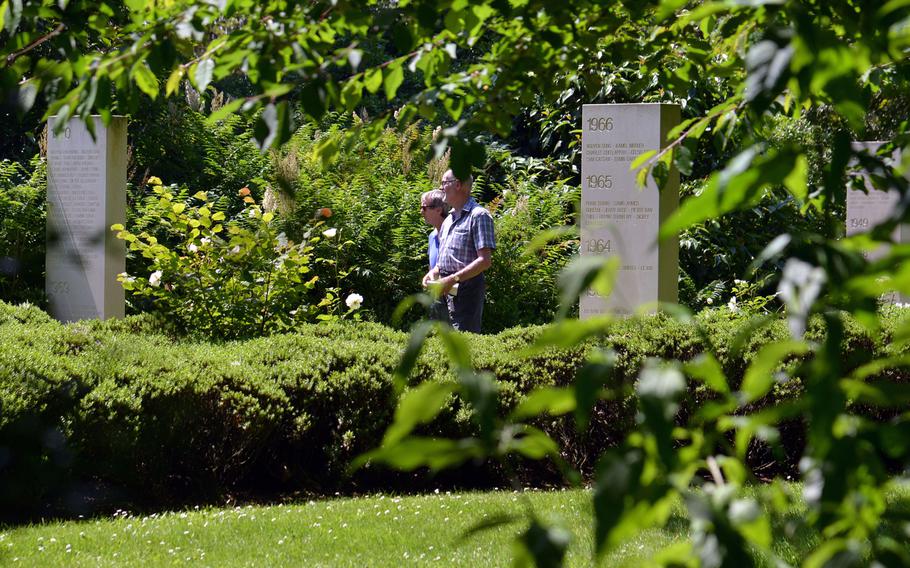
The 13th century Notre Dame Cathedral in Bayeux, France, towers over the streets of the city, as seen from a peaceful park. (Michael Abrams/Stars and Stripes)
Editor’s note: This story was originally published in 2019 to commemorate the 75th anniversary of the D-Day invasion. It has been republished ahead of this year’s 80th anniversary.
The 75th anniversary of the D-Day landings in Normandy will bring vast numbers of visitors to the memorials and sites along the invasion beaches, where some of the last veterans alive who helped win World War II will be honored.
If you’re thinking of going for the anniversary or during a quieter time, seeing where the Allies came ashore will be the highlight. But the town of Bayeux, a quick, 15-mile drive east from Omaha Beach, makes either a great side trip or a convenient place to stay while visiting the region.
Bayeux’s most famous attraction tells the story of a much older war that changed the course of history. It is home to the 230-foot-long Bayeux Tapestry, an 11th-century tale of the Battle of Hastings. Make sure to get the audio guide to hear how King William I — Guillaume to the French — conquered England and laid the foundations for what would become Britain.
The tapestry was at once a creative work and a brilliant piece of propaganda — few at the time could read, but the illustrations make clear who was “in the right” in a three-way feud among nobles and their armies.
From there, we walked to Rue Saint Jean, a main road that continues in varying names. On market days, vendors are out selling food and drink — with free samples — along with souvenirs, clothing, toys and even some livestock. While knowing a few words in French always helps, there are enough tourists from across the Channel that they’re likely to understand a little bit of English.
Some of the shops on the street sell specialties from the region, which is heavily agricultural. Their most famous beverage is calvados, an apple brandy that takes its name from the greater area. Pommeau, a mixture of calvados and local apple juice, is a mellower, tasty alternative. I’d also recommend buying a jar of fine-grained, spicy mustard, spiked with a dash of calvados.
After a free sample or five, we stopped for lunch at l’Alchimie, which offered a creative yet affordable three-course menu, paired with a wheat beer or a glass of wine. I doubt you’ll go wrong with seafood fresh off the boat in Bayeux.
We then wandered through some of the town gardens to the 13th-century Notre Dame Cathedral, a rebuilt Gothic church that started out as Norman-Romanesque in 1077, when King William came for the consecration. The Tree of Liberty outside dates to 1797 and is in some ways just as impressive for surviving so long.
Even amid the church’s serenity, reminders of war are never far away. Shops still sell bullet casings, helmets and other pieces of the WWII scrap that once blanketed the town. And less than a mile from the cathedral, the Bayeux War Cemetery memorializes the 4,848 servicemembers who died under the command of the United Kingdom and its commonwealth.

Visitors walks through the Memorial des Reporters, or Reporters Memorial, a park that on concrete slabs lists the names of over 2,000 journalists killed in the line of duty around the world since 1944. (Michael Abrams/Stars and Stripes)
Across the street from the cemetery is the Reporters Memorial, a forested park with pathways to concrete slabs that list the names of more than 2,000 reporters who, from WWII to the present, died in the pursuit of providing the public with information about their world. It’s a good reminder that journalism is so much more than a commentator you don’t like on a cable news channel.
slavin.erik@stripes.com Twitter: @eslavin_stripes
DIRECTIONS: Bayeux is accessible from multiple local roads and by train from Paris Saint-Lazare Station.
COSTS: The tapestry museum is 9.50 euros for adults, 5 euros for students and free under age 10.
INFORMATION: Online: bayeux-bessin-tourisme.com/en